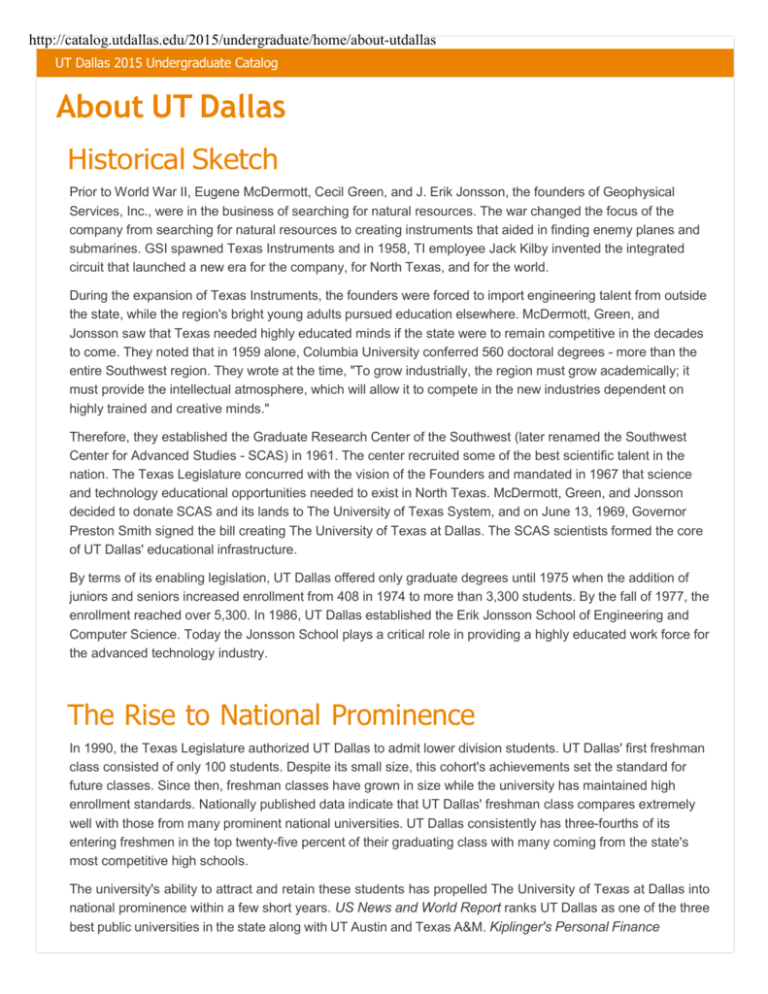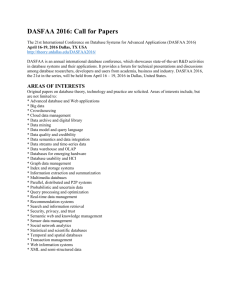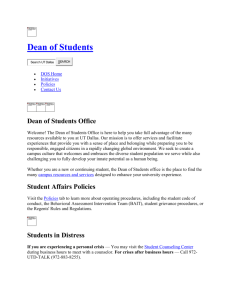UT Dallas 2014 2015 Undergraduate Catalog
advertisement

http://catalog.utdallas.edu/2015/undergraduate/home/about-utdallas UT Dallas 2015 Undergraduate Catalog About UT Dallas Historical Sketch Prior to World War II, Eugene McDermott, Cecil Green, and J. Erik Jonsson, the founders of Geophysical Services, Inc., were in the business of searching for natural resources. The war changed the focus of the company from searching for natural resources to creating instruments that aided in finding enemy planes and submarines. GSI spawned Texas Instruments and in 1958, TI employee Jack Kilby invented the integrated circuit that launched a new era for the company, for North Texas, and for the world. During the expansion of Texas Instruments, the founders were forced to import engineering talent from outside the state, while the region's bright young adults pursued education elsewhere. McDermott, Green, and Jonsson saw that Texas needed highly educated minds if the state were to remain competitive in the decades to come. They noted that in 1959 alone, Columbia University conferred 560 doctoral degrees - more than the entire Southwest region. They wrote at the time, "To grow industrially, the region must grow academically; it must provide the intellectual atmosphere, which will allow it to compete in the new industries dependent on highly trained and creative minds." Therefore, they established the Graduate Research Center of the Southwest (later renamed the Southwest Center for Advanced Studies - SCAS) in 1961. The center recruited some of the best scientific talent in the nation. The Texas Legislature concurred with the vision of the Founders and mandated in 1967 that science and technology educational opportunities needed to exist in North Texas. McDermott, Green, and Jonsson decided to donate SCAS and its lands to The University of Texas System, and on June 13, 1969, Governor Preston Smith signed the bill creating The University of Texas at Dallas. The SCAS scientists formed the core of UT Dallas' educational infrastructure. By terms of its enabling legislation, UT Dallas offered only graduate degrees until 1975 when the addition of juniors and seniors increased enrollment from 408 in 1974 to more than 3,300 students. By the fall of 1977, the enrollment reached over 5,300. In 1986, UT Dallas established the Erik Jonsson School of Engineering and Computer Science. Today the Jonsson School plays a critical role in providing a highly educated work force for the advanced technology industry. The Rise to National Prominence In 1990, the Texas Legislature authorized UT Dallas to admit lower division students. UT Dallas' first freshman class consisted of only 100 students. Despite its small size, this cohort's achievements set the standard for future classes. Since then, freshman classes have grown in size while the university has maintained high enrollment standards. Nationally published data indicate that UT Dallas' freshman class compares extremely well with those from many prominent national universities. UT Dallas consistently has three-fourths of its entering freshmen in the top twenty-five percent of their graduating class with many coming from the state's most competitive high schools. The university's ability to attract and retain these students has propelled The University of Texas at Dallas into national prominence within a few short years. US News and World Report ranks UT Dallas as one of the three best public universities in the state along with UT Austin and Texas A&M. Kiplinger's Personal Finance Magazine, in its February 2015 article "[Top 100] Best Values in Public Colleges, 2015," ranked UT Dallas 34th among all public universities nationally, gaining 21 spots from 60th last year. The quality of the students who attend UT Dallas has remained consistently high. Thirty-eight percent of the incoming freshmen are in the top 10% of their high school graduating class and their average SAT scores place them in the top twenty percent of all college-bound students. In recent years, UT Dallas has ranked among the top 100 American universities in terms of the number of National Merit Scholars enrolled. The addition of freshmen has accelerated the rise in the percentage of full-time undergraduates from 31% in 1986 to 81% in 2014. Masters, doctoral and post-baccalaureate students currently comprise 38% of the student body. Given its location and mission, UT Dallas will continue to have significant numbers of professionals attending undergraduate or master's courses part-time. The transition of the university from a part-time upper division school to a four-year university with an emphasis on engineering, mathematics, the sciences and the management of new technologies has been greatly facilitated by the university's faculty. By retaining key faculty members and attracting more nationally and internationally prominent researchers and instructors, UT Dallas has enabled its faculty to provide quality instruction to an increasingly diverse student population while sustaining the university's longstanding research tradition. In the past decade, the faculty has increased the level of external research funds substantially. During this same period, the university expanded its teaching mission, enhanced its areas of focused excellence and became independently recognized as one of the top public universities in the nation. Mission The University of Texas at Dallas provides the State of Texas and the nation with excellent, innovative education and research. The university is committed to graduating well-rounded citizens whose education has prepared them for rewarding lives and productive careers in a constantly changing world; to continually improving educational and research programs in the arts and sciences, engineering, and management; and to assisting the commercialization of intellectual capital generated by students, staff, and faculty. Organization The University of Texas at Dallas is one of nine universities and six health institutions governed by The University of Texas System's nine regents, who are nominated by the governor, selected from different areas of the state, and appointed with the advice and consent of the Texas Senate. UT Dallas consists of seven schools, each headed by a dean: School of Arts and Humanities, School of Behavioral and Brain Sciences, Erik Jonsson School Engineering and Computer Science, School of Economic, Political and Policy Sciences, School of Interdisciplinary Studies, Naveen Jindal School of Management, and School of Natural Sciences and Mathematics. The schools, in turn, consist of teaching and research programs that provide the disciplinary foundations of the university. In addition to the usual disciplinary approaches, the university has a strong commitment to interdisciplinary study at both the graduate and undergraduate levels. Most faculty members teach in both graduate and undergraduate areas so that the character of their instruction is informed by critical examination of the most recent developments in their fields. Each of the university's schools contains an undergraduate college, headed by an Associate Dean of Undergraduate Education (ADU) who coordinates the undergraduate programs and academic advising within the college. These colleges of The University of Texas at Dallas provide undergraduate students with a personalized setting in which they may pursue their academic careers. Each college offers an intellectual and social home for undergraduates within the larger university. The Office of Undergraduate Education coordinates undergraduate education across the seven schools. The Council for Undergraduate Education (CUE), chaired by the Dean of Undergraduate Education, oversees academic advising and degree requirements, and develops and implements educational policy.








